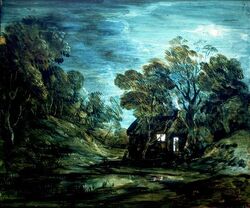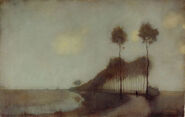The looting of Brunanter art refers to the looting of paintings, sculptures, drawings, books and other cultural treasures and monuments from Brunant during the German occupation during World War II.
Museum collections[]
Brunant's national collection, including works owned by the Royal Family and those in the National Museum of Art, were being catalogued and stored from early 1940. A few works were scattered throughout the countryside, but most of the collection was stored and smuggled out of Brunant with the Royal Guard in May 1941, to Malta and Alexandria (Egypt). A few paintings would be illegally sold to the Nazis and little was left to loot. Despite that the royal palaces saw many large sculptures and decorations looted or damaged, with very few being recovered after 1945.
Unlike the NMA, few of the private museums were as lucky. The Del Bosque Museum in Grijzestad, probably the largest collection of classical and neoclassical works, was unable to disperse of its collection. Many of these old masters' works, by Rickard Helsenberg, Gerard Blomefont van Stein, Hans Fabre, Antonius Hasselman and others were sold off to Nazi art collectors, and it is believed that between 30 and 40 went to Hermann Göring's collection. Other museums sold their works to Brunanter Nazis and collaborators to ensure they remained in Brunant.
After the war, some 70 paintings belonging to the Del Bosque Museum were recovered in Germany and Brunant, though some 250 were still missing. In 1997, police responded to a fire in a Sint-Willemstad home and discovered that the fire was caused by a burning painting, part of a collection of nearly 300 old masters, recovered from the 80 year old owner. The provenance of around 50 or 60 was unknown; while some were believed to have been legitimately bought, the majority were looted or sold under duress.
Van Neyt collection[]

Gerard Blomefont van Stein, Roodstad Farmhouse (1727)
The Neyt family had amassed a large collection of classical paintings and drawings, and in their collection of 15th to 19th-century works, they had some 650 paintings stored in family residences and loaned out to museums. Nearing the start of the German invasion, the family sold off some of the best-known works to a Brunanter art dealer in New York, including The Burgundian Bride.
The family was allowed to keep their works by the Nazis, but some 30-40 were sold to the authorities. It was not known if these works were legitimately sold or were forced on the family, and many works by Jan van Helsinger and Gerard Blomefont van Stein are believed to be missing, most likely still in Germany.
Murais collection[]

The Spanish-Jewish Murais family had amassed a collection of 17th and 18th-century works, primarily focusing on Hans Fabre, though it also included many Spanish works. By 1930, they had nearly 600 works, the largest in private hands at the time, of which The Primordial Orgy was probably the finest, in their possession since 1653.
In 1941, following the German invasion, most of their works were confiscated by the authorities. Noted art dealer Crispin van Holme oversaw the collection and presented eight works to Hermann Göring. The Primordial Orgy was damaged in a fire between 1942 and 1944. Many paintings were sent to Nazi Germany and 63 were retrieved in Merkers, though the majority remained in Brunant.
The paintings were largely returned to the family, but six paintings of unknown provenance, believed to have been sold by the Murais, were not returned to them.
Modern art[]
Much of the privately-held modern art was confiscated by the authorities in 1941 and 1942. Works by Caroman, Stefan Malphy, Marie Durand, Abraham Hillard, Felix Prado, Raoul Dufy and others fell prey to looters and many works were sent to Germany and were most likely destroyed. Around 120 paintings by many modern artists were kept by NSF leader Cristian Everard, including the only pre-war Prado still in existence. These works were kept by Everard and with Brunant's liberation in 1944, they were hid in a farmhouse south of Carrington. These works would be discovered in December 1945.


